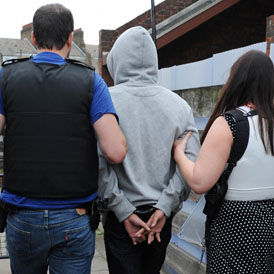More than 1,000 people charged with riot offences – Met
The Metropolitan Police says that more than 1,000 people have now been charged following several days of rioting across the capital.
Metropolitan Police Acting Commissioner Tim Godwin hailed a “significant milestone” as he said a total of 1,005 suspects had been charged after 1,733 arrests so far.
Mr Godwin, who said at the weekend that the force was targeting 3,000 riot-related convictions, added that the investigation is “far from over”.
But the post-riot conviction rate and sentencing have been welcomed by some senior figures in London. The capital’s mayor Boris Johnson said: “To have already charged 1,000 people is a testament not only to their dedication, but also to the outstanding support they have had from law-abiding Londoners who will not tolerate this behaviour in their communities.
“We have shone a torch on London’s criminal fraternity, and this milestone sends out the clear message that offenders will be made to pay for their appalling actions.”
The case of Shonola Smith demonstrates sentencing far in excess what would be indicated by the guidelines. Stephen Whitehead
But there have been concerns that sentencing is disproportionate to the crimes committed after two men were sent to jail for four years for trying to organise disorder in Cheshire via Facebook and one organisation has told Channel 4 News that in hindsight the sentencing could be seen as too tough.
‘Harsh and counter-productive’
Critics have told Channel 4 News they doubt the long-term benefits of the current sentencing trend. Steve Hynes, director of the justice charity the Legal Action Group, said: “Of course courts should have the discretion to react to events; judges are reacting to a near breakdown in law and order, but they are disproportionate.
“In exceptional circumstances such as these, where public order is at stake, to err on the side of harsher punishments is probably right. But with the passage of time we believe some sentences currently being handed down will seem too harsh and counter-productive.”
The sentences are not disproportionate given the wholly unusual set of circumstances. Ian Kelcey, Law Society
Of course, headlines do not include the details of individual cases which judges consider when passing sentence and although some sentences may appear harsh, there may also be mitigating factors (such as the intensity of last week’s disorder,) which may mean the offence merits tougher punishment. Nonetheless, the question of what is an appropriate sentence remains.
‘Throw away sentencing guidelines’
Following the riots and criticisms that earlier sentences had been too lenient, Novello Noades, chair of the bench at Camberwell Green magistrates’ court in south London, was quoted as saying: “Anyone with any involvement must be dealt with as severely as we possibly can. Only custody is appropriate. Our directive for anything involved in rioting is a custodial sentence. So the question is whether our powers are sufficient or not. It is a very, very serious matter.”
Stephen Whitehead, crime and justice researcher at New Economics Foundation told Channel 4 News that sentences certainly appear to have become more strict.
He explained: “It is indisputable that many of those convicted of rioting have received sentences far beyond what is specified by sentencing guidelines, or pre-existing case law.

“For example, the case of Shonola Smith demonstrates sentencing far in excess what would be indicated by the guidelines. In that case, Smith received six months in custody, but given the circumstances of the offence (little or no planning or sophistication and goods stolen of low value,) the guidelines suggest that sentencers should start from the sentence of a fine before considering aggravating and mitigating factors.”
But Ian Kelcey from the Law Society believes that the sentences result from a “wholly unusual” set of circumstances and that they are proportionate.
“I think the courts are providing a little in the way of scare tactics. These sentences are sending a message to the public that this behaviour is unwarranted and unacceptable and serve to discourage people from getting involved in similar behaviour,” he said.
“The sentences are not disproportionate given the wholly unusual set of circumstances and I think the court of appeal will uphold them.”
Jailing a young person costs state ‘at least’ £140,000
But there is evidence that in the long-term, there is a significant financial cost to the state for, for example, jailing young people rather than handing out non-custodial sentences. The New Economics Foundation estimated that the costs and benefits of holding a young person in a Young Offenders’ Institution for a year add up to at least £140,000 in expenses to the state.
Costs of sending young people to jail (2010 figures)
– Sending one young person to a Young Offenders’ Institution £42,000
– 1 year Community Rehabilitation Order £3,000
– 1 year Community Punishment Order £2,000
– 1 year Community Punishment and Rehabilitation Order £4,000
– 1 year Drug Treatment Order £8,000
– 6 month ISSP £6,000
Source: Civitas
The Government’s own sentencing green paper last year noted that custodial sentences were less effective than non-custodial sentences in terms of re-offending rates: “In 2007, reoffending of those offenders starting community orders was 7 per cent lower than for similar offenders who had served short term prison sentences.”
The paper also put forward guidance that the Government ‘intends to remove the option of remand in custody for defendants who would be unlikely to receive a custodial sentence’. It remains to be seen whether following the riots, this approach is retained.